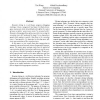86 search results - page 3 / 18 » The Use of Traces for Inlining in Java Programs |
ICSE
2004
IEEE-ACM
14 years 5 months ago
2004
IEEE-ACM
Dynamic slicing is a well-known program debugging technique. Given a program P and input I, it finds all program statements which directly/indirectly affect the values of some var...
CAV
2012
Springer
11 years 8 months ago
2012
Springer
Abstract. We propose a trace-based concurrent program analysis to soundly remove redundant synchronizations such as locks while preserving the behaviors of the concurrent computati...
HIPEAC
2011
Springer
12 years 5 months ago
2011
Springer
Dynamic typing is a barrier for JavaScript applications to achieve high performance. Compared with statically typed languages, the major overhead of dynamic typing comes from runt...
ESOP
2005
Springer
13 years 11 months ago
2005
Springer
: Fully abstract trace semantics for a core Java language. Alan Jeffrey 1,2 and Julian Rathke3 1 Bell Labs, Lucent Technologies, Chicago, IL, USA 2 DePaul University, Chicago, IL, ...
ICPP
2007
IEEE
14 years 2 days ago
2007
IEEE
We propose and evaluate a novel approach for automatic parallelization. The approach uses traces as units of parallel work. We discuss the benefits and challenges of the use of t...

